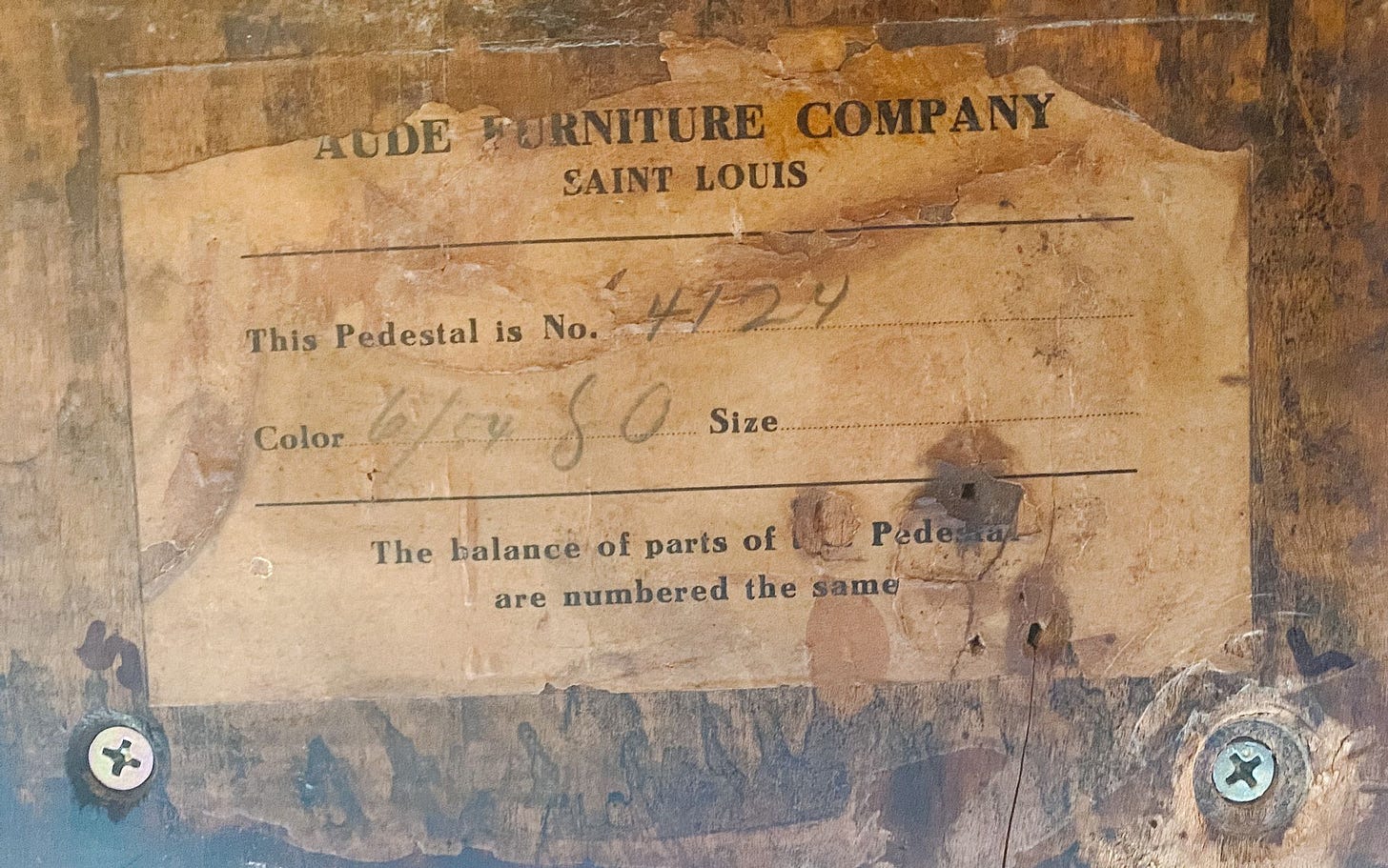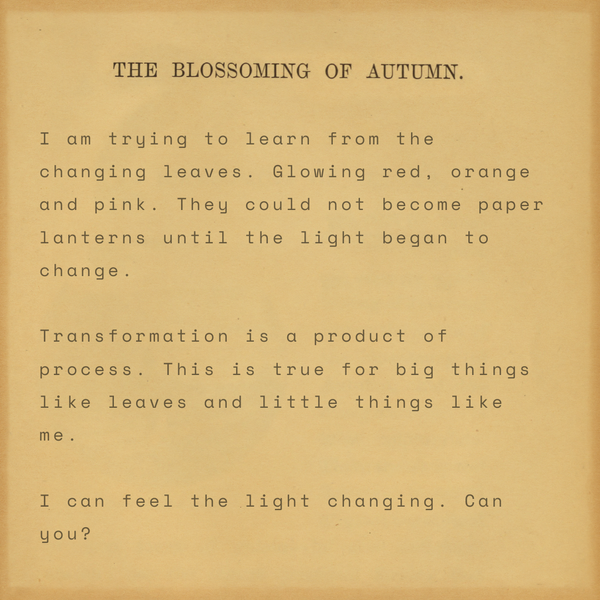A Crowded Table
I own the table of my dreams because someone was desperate.

Round tables are big in a way a long table never can be. Maybe it’s a Knights of the Round Table thing. No one can be at the head of a round table, so everyone sits equally around it. Maybe it’s the lazy susan affect. Food on a round table is always within reach and so everyone is fed. Maybe it’s just how close you can scoot chairs together. Without any corners to get in the way, there’s always room for one more.
We’ve always wanted a big round table but new ones are difficult to find on a budget. That’s alright. New furniture isn’t sustainable or storied. We checked Craigslist every few months, waiting for the perfect used table. A week ago, an ad came up for an early 20th century 54” round table - with leaves! The ad was curt: landline only, no texting, no email. Cash only. My husband called the number and left a voicemail. A voicemail! This was already a journey to the past. When she called him back, the seller sounded a little elderly. She explained that she and her husband spend their retirement finding furniture to refinish and sell. The woman, her husband and the table were an hour’s drive from us. Riley and I decided to don masks and make a date of it. On the drive, we talked about how nice it would be to revitalize old pieces of furniture as we got old ourselves.
We met the sellers at a storage facility between two grids of tract homes. All three were gated and greige. The woman and her husband were older than we expected. It took each of them some effort to climb down from their truck. When the man pushed the storage unit door up, I clapped my hands. Chairs from the turn of the 19th century hung like coats on each wall. Mid-century bureaus stood next to 1920s buffets. A pink metal hamper from the 1950s touched corners with a wire bar cart from the 1930s. If you cropped out garage door and stucco, it looked like a shop you’d stumble upon in a city older than America. It was easy to imagine a flower stand and bakery just out of frame. Uncropped, the storage unit was proof the suburbs hold many beautiful things. Everything was dusted, even the pieces stacked on one another in the back.
Our table had been pulled to the front. Refinished but not too refined for our house full of children. They showed us where they'd filled in a dent and how to unlatch the metal clasp so we could add leaves. One part was left untouched, a spot under the tabletop where the manufacturer pasted a label. Aude Furniture Company, Saint Louis. In 1891, the Aude Furniture Company sat at the corner of Cass Avenue and 16th Street. In 1904, they exhibited their wooden wares at theWorld’s Fair in St. Louis. Aude Furniture Co. built my table about sixteen years later. In the decades since, someone put wheels on the base. A moveable feast! We’d take it.

The man bent down to unscrew the table top from the pedestal so we could fit it in our minivan. His knuckles and fingers were thick with arthritis. He had a hard time getting onto his knees, so Riley helped him. I turned to his wife,
“I am envious of what you do here. Finding old things and giving them new life. What a beautiful way to spend your time.”
Her mouth twisted into that space between smile and grimace,
“This isn’t what we want to do. We lost our retirement. We can’t live on Social Security. So we do this. He’s 79 and I am 78. Every day I wake up wondering how much longer he can do this. He does all the refinishing but it’s getting harder for him. I handle the selling.”
I didn’t know what to say, so I told her I was sorry. And I was. I wanted my sustainable table to have a sustaining story. So I told her the story I saw, instead of asking for the story she’s lived. Her story is the story so many of our elderly brothers and sisters.
There isn’t a county in America where Social Security completely covers the cost of living. Wyoming County, West Virginia has the smallest gap between benefits and cost of living. Retirees in Wyoming County endure a $2000 a year gap between benefits and their cost of living. The elderly in San Francisco County, California are blighted with a $30,000 a year gap. Half of adults 65 and olderliving alone don’t have enough money to cover basic needs. A quarter of households with two elders don’t have enough money to provide for themselves.
Grandparents caring for their grandchildren full-time are especially vulnerable. If they do not have custody, a common situation, they cannot qualify for benefits to feed their grandbabies. Social Security goes to food for the children while the elderly adults go hungry. When we don’t care for children first, the suffering goes forwards and backwards for generations. It’s very difficult for our elderly to fill in the financial holes. Some babysit, some clean houses, some refinish furniture, and some fall right into the gap and never get up again.
After we paid in cash and promised to leave a voicemail whenever we needed another piece, we said goodbye. On the way home, Riley and I talked about how some work bestows dignity and other work strips it away. I don't know where this couple's work falls. Perhaps it’s not mine to say. I do know I can’t stop thinking about that man’s thick knuckles or the woman's disappearing smile.
The table looks lovely in our home. It warms the space. We all fit around it with room for one more. When I clear breakfast plates, I think of all the crumbs wiped from its top. Our table was built shortly before The Great Gatsby was published. Maybe someone sat at it eating a sandwich while first encountering Daisy and Jay. Perhaps it was set with plates not quite full enough during the Great Depression. It’s possible a woman stood next to it in 1944, tapping its surface, waiting for a letter from a loved one at war. Maybe if I look close enough, I can find her nail prints. People cried around our table, but they laughed too. Our table went through the boom of the 50s and the bust of the 70s. Maybe it wandered for a few decades, shuffling between homes and consignment stores. It spent last year being found, refinished and standing in a storage space. Over the next decades, it will witness my children.
I love old furniture because I love stories. But stories are more than patina. I can’t choose the stories that I love while ignoring the stories that demand something of me. I have this table because two people are not being cared for by the society they helped build. That is part of our table’s story too. Every night when I lay placemats on our table to protect the finish from weeping water glasses, that story asks a question,
"Was I as diligent in protecting the people who finished this table as I am of the stain they brushed across it?”
What do we do with this particular story, and all the stories like it?
Build a round table, I think. No one can be at the head of a round table, everyone sits equally around it. Food on a round table is always within reach, so everyone is fed. Without any corners in the way, we’ll scoot our chairs together to fit one more. Mutual aid, the formation of co-operative care networks, is a great, time-tested way to build a round table. If you are in Colorado and want to know more, here is one place to get started.




